Colombia's Ex-rebels Remove Mines They Left During War
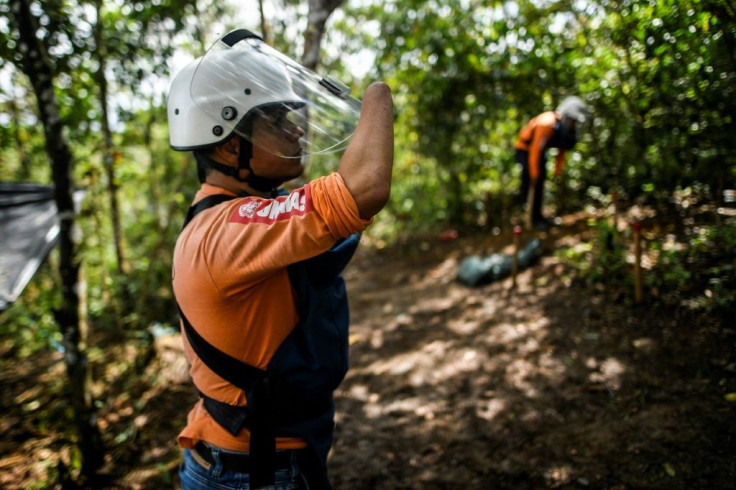
A grenade blew off the hands of onetime FARC guerrilla Edwin Correa, but he only surrendered his rifle once a peace deal was struck nearly three years ago.
Since then, the former bomb expert has joined a different sort of fighting unit -- one dedicated to removing the land mines in Colombia's countryside that he once helped to plant.
"I spent nearly my entire life as a rebel. (...) We placed mines that we are now eliminating ourselves," the 36-year-old Correa told AFP.
Correa joined the leftist Revolutionary Armed Forces of Colombia (FARC) when he was just 14 years old. By the age of 19, he had lost both hands.
In order to fire his rifle, he would brace it against his shoulder with the remaining stump of his arm and pull the trigger with a cord.
Today, he dons a bulletproof vest and a protective visor without assistance. Four other former rebels work under his command.
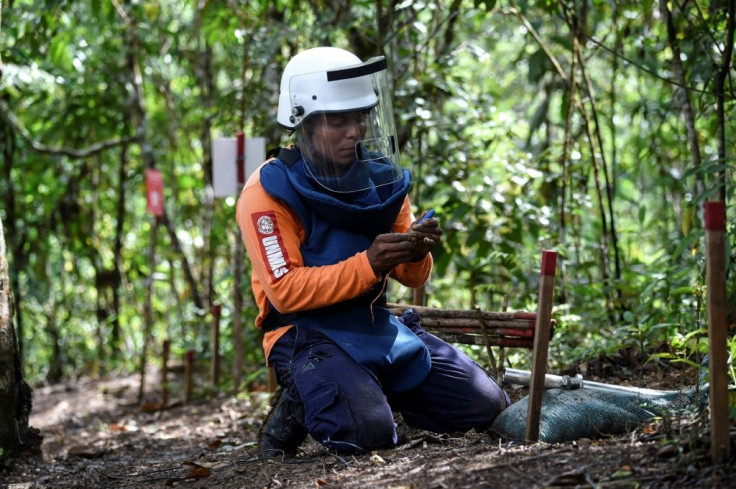
The group wields metal detectors as they advance on a path marked with white sticks to a wooded area believed to be booby-trapped in the countryside outside the southern town of La Montanita.
They scan underneath shrubs for mines buried at the site for the purposes of their training course. They learn how to isolate the explosives by tagging them with cords and sticks painted red.
Then, they gently remove them from the ground, which is currently sodden from the last tropical rainstorm.
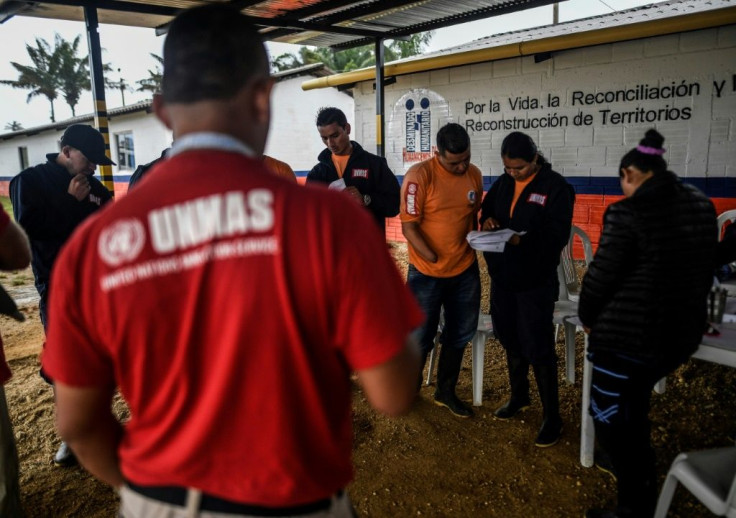
The group then retreats to a safe distance -- 100 meters (yards) or so -- and detonates the mines by pulling black cables attached to them.
La Montanita is in the heart of the Caguan region, a former stronghold for the rebel group founded in the 1960s. It is also among the towns in Colombia with the most land mine victims.
Farming without fear
The area is also now the home base of Humanicemos DH, an organization that helps former rebels who want to become professional deminers, says director Angela Orrego, a former rebel commander herself.
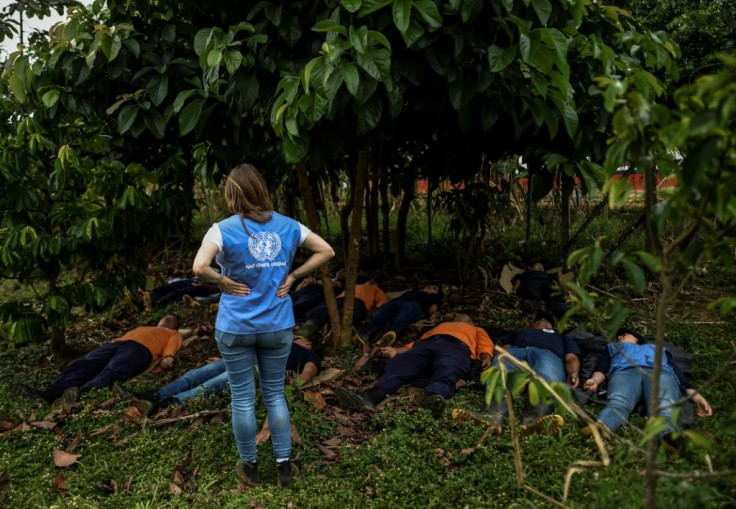
Some 7,000 fighters have surrendered their weapons since the November 2016 signing of a peace deal between the FARC and the government of then president Juan Manuel Santos.
Correa and about 100 of their former brothers-in-arms joined Humanicemos last year. The group is funded by the United Nations and the European Union with an annual budget of $1.2 million.
As they await full certification as deminers, they get training from experts with the UN Mine Action Service. They also get computer training, English classes and even learn about meditation.

After Afghanistan, Colombia is the country worst affected by leftover land mines. They were planted in 31 of the country's 32 departments by all sides in the bloody decades-long conflict -- rebels, paramilitary fighters, armed forces.
Correa, who spent years laying explosive devices, says he feels "useful" by leaving locals land stripped of mines "so they can plant crops, harvest and move about easily."
Mines to protect coca plants
Since 1985, mines and other unexploded ordnance have struck more than 11,780 people. In 20 percent of those cases, the incident was fatal, according to Colombia's high commission for peace.
Land mines "still affect the lives of millions of people because every hour, they claim a new victim," says the country's national center for historical memory (CNMH).
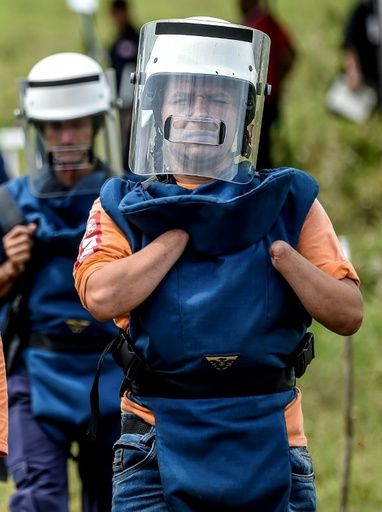
The mine removal training in La Montanita is taking place near a center where about 300 ex-rebels and their loved ones live.
The location, in a strategic corridor linking eastern and western Colombia, was chosen by design.
"There were many battles here involving the army, the rebels and the paramilitary fighters because of the coca," the primary ingredient in cocaine, says German Balanta of Humanicemos.
In a civil conflict like the one in Colombia, mines are "an important weapon that allows small-scale forces to face larger ones," Balanta explains.
Porfirio Andrade, a representative of a victims' association cited in a CNMH report, recalled that the guerrillas "said they had to use them to defend themselves."
But, he added, "in reality, in a coca plantation zone, mines are used to kill."
Today, mines are still used by fighters from the National Liberation Army (ELN), Colombia's last active rebel group, as well as dissident FARC fighters who rejected the peace deal and drug gangs.
Difficult to find
Often made with whatever is available -- plastic bottles, PVC pipe, other containers -- and armed with a spring mechanism, the mines contain TNT, which does not degrade in the high humidity.
So they can remain live for up to 15 years.
In addition to their long shelf life, there is no real catalog of where the mines are placed, complicating the task of finding and removing them.
Some were hastily placed in battle to slow down enemy forces. Others were buried by combatants who have since died, in places where the vegetation has changed or even in zones shifted by earthquakes.
Before the peace deal was reached, then defense minister Luis Carlos Villegas warned that the mines would be the "biggest challenge of the post-conflict period."
"Demining Colombia will take a generation, tens of thousands of experts and a lot of international cooperation," Villegas told AFP in late 2015.
Colombia -- a signatory to the so-called Ottawa Treaty, also known as the Anti-Personnel Mine Ban Convention -- wants to be clear of all mines in 2021.
But the government of President Ivan Duque said in March that it would need more time.
For now, because of a legal dispute, the ex-rebels trained through Humanicemos cannot join the roughly 6,000 mine removal experts already accredited to work in Colombia.
Their certification has been delegated to the Organization of American States. But the United States is a member of the OAS and it has yet to remove the FARC from its terror blacklist.
The UN says it is ready to take charge.
"We're in talks with the government ... to get this done," said Jan-Philip Klever, the Colombia project manager for UNMAS.
© Copyright AFP {{Year}}. All rights reserved.





















